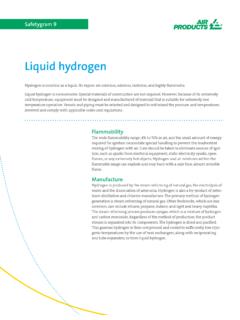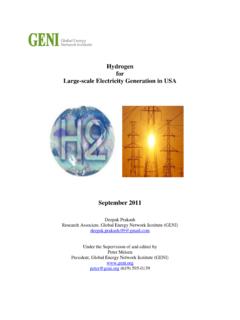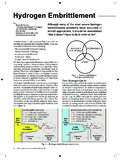Transcription of Hydrogen Induced Corrosion - mavery.com
1 Hydrogen Induced Corrosion Material Science 112 Group Research Paper March 12th, 2001. Matthew Avery Benjamin Chui Y. Gordon Kariya Kenneth Larson Avery, Chui, Kariya & Larson Introduction One typically thinks of Corrosion as electrochemical reactions that destroy metal surfaces through oxidation. Hydrogen Corrosion works through mechanisms in which metals are weakened internally. Due to its relatively small size, Hydrogen is able to penetrate into metals and affect properties such as strength and ductility. This occurs through embrittlement, blistering, precipitation, hydride formation, and reaction with embedded carbon.
2 This paper describes the sources of Hydrogen Corrosion , the details the mechanisms of Corrosion and methods used prevention. Sources of Hydrogen Corrosion Hydrogen damage of metals occurs when Hydrogen is absorbed in metal and thus weakens the load-carrying capacity of the metal. Metals absorb Hydrogen when in an environment that contains or generates Hydrogen . This can be during the production, processing, and/or the service of the metal. Hydrogen can be absorbed during the production of forged steel. In steelmaking, Hydrogen comes from the moisture in the atmosphere and from additives used during processing.
3 It dissolves more in the high-temperature FCC austenite state ( -iron) than in the lower temperature BCC ferrite state ( -iron). Therefore, when Hydrogen is absorbed in the -iron state and subsequently cooled, the individual Hydrogen atoms precipitate in the -iron at inclusions or micropores. The pressure of the Hydrogen gas creates what are called flakes in the metal, causing embrittlement. Similar damage can occur when steel is welded in an environment that contains Hydrogen , which can be introduced through atmospheric or surface contamination. As the welded metal containing Hydrogen cools, it becomes super-saturated, and Hydrogen diffuses into the surrounding metal heated during the process.
4 As a result, the area around the weld becomes embrittled by subsequent Corrosion . Hydrogen can also be absorbed by metal during aqueous Corrosion or cathodic charging. When Corrosion occurs in a low-pH solution, some of the reduced Hydrogen does not form H2, but instead, diffuses into the metal as atomic Hydrogen . This can happen during pickling and electroplating of metal. Substances such as arsenic, antimony, sulfur, selenium, tellurium, and cyanide ions prevent the Hydrogen atoms from forming H2, and are called cathodic poisons. Cathodic poisons facilitate contamination by keeping Hydrogen in atomic form, in which Hydrogen more readily diffuses into the metal.
5 Environments containing Hydrogen sulfide, which contains both Hydrogen and a cathodic poison ( sulfur), are especially dangerous for alloys and metals. Hydrogen sulfide is often encountered in the petroleum industry during the drilling and completion of oil and gas wells, and during the storage and piping of petroleum products containing Hydrogen sulfide. If steel is in a Hydrogen environment of high temperature and pressure, Hydrogen attack can occur. Hydrogen is absorbed into the steel, and although the steel may appear fine for a while, it will suddenly lose its strength and ductility.
6 The Hydrogen reacts with the carbides inside the steel. This delayed attack is encountered in petrochemical plants, where Hydrogen and hydrocarbon streams are at high temperatures and pressures. 2 of 8. Avery, Chui, Kariya & Larson Hydrogen can react directly with the metal to form hydrides. This can occur in metals such as titanium, zirconium, uranium, and their alloys. The formation of hydrides can severely weaken these metals. For example, zirconium hydride is so brittle and weak that it can be crushed into powder. Hydrogen can be absorbed during melting, welding, or pickling; it can also be absorbed from water vapor and hydrocarbons.
7 Aside from Hydrogen attack, which occurs at high temperatures, the majority of Corrosion occurs at ambient temperature. This is because at high temperatures, the mobility of Hydrogen is great enough that there is little accumulation of it at any one location in the lattice. Once ambient conditions are met, solubility decreases and causes pockets of Hydrogen to form. This compounded with the decrease in mobility traps the Hydrogen within the metal lattice. The process by which Hydrogen accumulation leads to Corrosion is the topic of the next section Principles of Hydrogen -Assisted Corrosion Hydrogen Embrittlement The presence of Hydrogen in steel reduces the tensile ductility and causes premature failure under static loads that depend on the stress and time.
8 This phenomenon is known as Hydrogen embrittlement. Although many mechanisms of Hydrogen embrittlement have been proposed, all can be classified according to one of three theories: the planar pressure theory, the reduced surface energy theory, and the decohesion theory. All of these theories are explored below. The basic processes involved in Hydrogen embrittlement are illustrated in Figure 1. Steel can be embrittled by a very small amount of Hydrogen , on the level of a few parts per million. This Hydrogen may come from some of the many sources described above. Unlike other modes of environmentally-assisted cracking, such as stress Corrosion cracking, cracks caused by Hydrogen embrittlement usually do not branch.
9 Cracks can develop by both transgranular and intergranular paths. The path of crack growth in Hydrogen embrittled steels is a function of the stress intensity factor, K (MPa m). Examples of crack growth due to Hydrogen embrittlement are schematically shown in Figure 2 below. 3 of 8. Avery, Chui, Kariya & Larson Failure caused by Hydrogen embrittlement is usually accompanied by very little plastic deformation. The fracture mode is usually brittle cleavage or quasi-cleavage fracture. In general, materials become more vulnerable to Hydrogen embrittlement with increased strength.
10 This behavior is supported by the decohesion theory of embrittlement. Decohesion theory states that dissolved Hydrogen migrates into a triaxially stressed region and embrittles the lattice by lowering the cohesive strength between metal atoms. This type of fracture is shown in Figure 2a above. During stress cracking, in front of a crack tip there is a localized region where stress is a maximum. On the crack surface, Hydrogen gas will physisorb near the crack tip. The Hydrogen gas then breaks into atomic Hydrogen via chemiadsorption, and the atomic Hydrogen will preferentially migrate towards the region of localized maximum stress in front of the crack tip.





